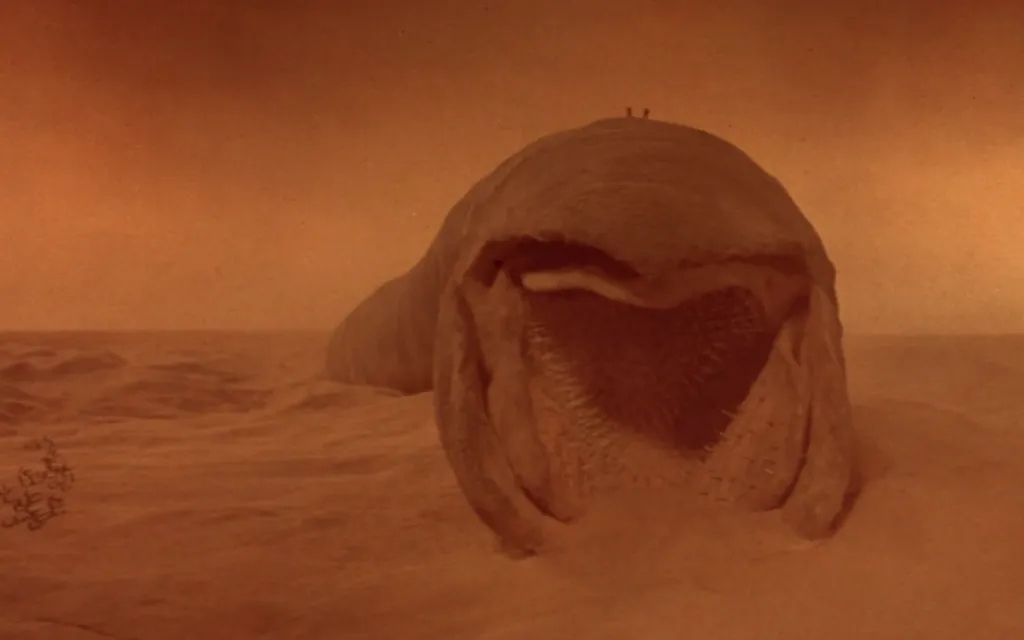Maybe both – an analysis of two versions of “Dune”
I re-watched the other day “Dune” — not the recent version, but the 1984 version by David Lynch. Then I watched only the first 20 or 30 minutes of the new “Dune” (2021) and could not go on. I had disliked the previous movies that I watched by the over-hyped Dennis Villeneuve, including his “Blade Runner” sequel, and saw no much point in continuing.
Lynch’s version of “Dune” has a lot of defects, and in fact it seems he has disowned his film and doesn’t even like to talk about it. He had a lot of trouble making it, it was a bomb at the box office and critics panned it. Frank Herbert readers in particular hated it.
Me? Well, I had seen it in cinemas back when it came out and even then I thought it was enjoyable. A few scenes even remained in my mind, which is more than I can say from most movies I watched in the 1980s. And I did read the book, at least the first one of the series (I don’t remember if before or just after seeing the movie). To be honest, I don’t think it made that much of an impression on me. I remembered more the movie than the book.
Watching Lynch’s film now for a second time, I thought it was a lot of fun, even if very irregular and, as a whole, disappointing.
The main problem of the film is that it tries to fit way too much content in too little time, in particular during the second half of the film. The first half is not too bad in terms of rhythm, but the second one is almost ridiculously telegraphed, with important scenes and plot points taking place in just a few seconds or in an expository line of narration. It feels like a whole of buildup to very little climax.
It is hard to adapt novels to the screen, in particular long and multilayered novels. In fact, Lynch’s movie starts with a character talking directly to the audience and explaining the main situation. It’s a bit clunky, but it works. Another interesting trick Lynch uses is to have the characters’ thoughts or inner voice as audio over a character’s close-up. Not a voice-over narration, but really what each character is thinking at that exact time, as we would have in a novel. It does work, but it can be a bit disorienting at times.
The cast is exceptional, including Max Von Sidow as a Fremen, José Ferrer as the Emperor, Silvana Mangano in a small role as Mother Superior, and Kyle McLahlan in one of his first roles (he would become one of Lynch’s most iconic actors). But the Reverend Mother played Sian Philips is probably the most memorable one, together with the grotesque Baron Harkkonnen played by Kenneth McMillan.
Today, the adaptation of a similar long, complicated novel would probably be done as a 10-episode series, or at least as a movie trilogy (as it seems Villeneuve is doing), which would be more adequate, but I guess that wasn’t the norm at the time. Today, even mediocre movies get a trilogy or several sequels and prequels.
I think the main problem was that the producers seem to have imagined some kind of “Star Wars” with lasers and funny aliens and robots, when “Dune” is more a thinking-man’s science fiction, like, say “Blade Runner”. But “Blade Runner”, which, by the way, was also done during the same period (1982), also didn’t do well. While it is considered a classic today, it was a big flop at the time, too.
In retrospect, it is weird that they hired David Lynch for this movie, based solely on “Eraserhead” and “The Elephant Man”, and expecting him to deliver a blockbuster. Perhaps the idea was that he would create interesting alien monsters, which he did, but it is a type of big budget sci-fi film that is very different to the movies that would later define Lynch’s style, from Blue Velvet to Twin Peaks to his masterpiece Mullholland Drive (which I am currently watching again and might later write about).
I haven’t seen all of Villeneuve’s “Dune”, so I cannot give a full appraisal, but, as mentioned, I saw the trailer and the first 20 or 30 minutes, and was not impressed. While technically it might be a “better” film than Lynch’s “Dune” — it has a tighter script, better editing, etc — it seems to showcase all the main problems of modern movies. Such as:
Casting: Timothée Chalamet is a good actor, but he hardly seems adequate as someone who becomes a warrior and military leader. It used to be that movie actors mostly specialized in certain types — John Wayne played tough guys, Humphrey Bogart played, well, the Humphrey Bogart type. But now the choice of cast seems to be only about who is more in vogue at a certain time. Adam Driver, for instance, is an actor I don’t like very much, but who has been cast in all kinds of roles, from Star Wars villain to sensitive poet to action hero. Of course, the other problem of modern casting, and very much visible in “Dune”, is the forced diversity even in cases when it makes no sense. I guess this is unavoidable in today’s multicultural planet, but it is still a bit annoying. I suppose even alien civilizations are multicultural.
Cinematography: For some reason, most modern movies tend to have a very monochrome photography, usually reduced to a small palette of colours, in this case, mostly towards brown and grey. Compare today’s movies to the Technicolour films of the 1960s (Hitchcock’s “Vertigo”, Fellini’s “Juliet of the Spirits”, Powell and Pressburger’s “Black Narcissus”, etc.) and it’s a different universe. I am not sure if this is related just to technique or to aesthetic concerns, or to the fact that the past really was more colourful. Someone observed a while ago that the modern age tends more towards the monochrome — people use mostly black or gray clothes, for instance, or tend to like black and grey cars, and mostly white interior decoration.
CGI: Modern movies use and abuse too much CGI. Part of the fascination of Lynch’s 1984 version is the use of traditional effects — the sand worms, for instance, are created as miniature puppets, they even used miniature sand for some scenes. To my mind, it works better, or at least gives you an idea of something “real”. CGI always tends to look as CGI. Just compare Lynch’s organic sand worms with Villeneuve’s computer sand worms which are ugly and unappealing and unreal.
Art Direction: Lynch’s version has a lot of defects, but all in all it’s a very “Lynchian” movie, in particular in the artistic design, with grotesque creatures and visually inventive clothes and characters. Villeneuve’s version seem much more generic, just as his “Blade Runner” sequel was generic and boring. For instance, Villeneuve’s Fremen are clearly more inspired by the traditional garb of Arab and Berber warriors (this comes from Herbert’s novel, clearly inspired by the early Islamic invasions — it even mentions “jihad”). While Lynch doesn’t discount such influence, he creates more original designs. In particular, the Bene Gesserit nuns, which in Lynch’s “Dune” are very striking, with their shaved head and the weird tunics which make them something between burkas and something out of Ancient Egypt. In Villeneuve’s version, they just basically seem women dressed in black hoodies.
Villeneuve’s “Dune” has a rating of 8.3 in IMDB, even though for me it was well-produced crap, while Lynch’s “Dune” has a 6.3 rating, even if it is a more imaginative failure.


